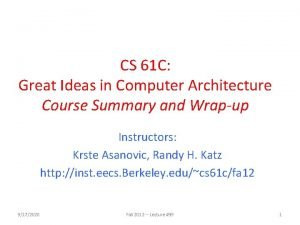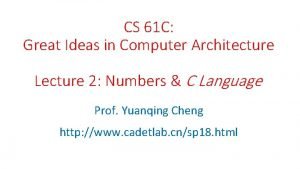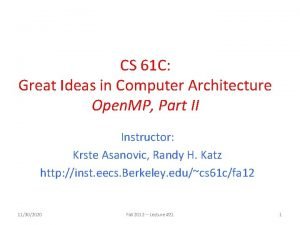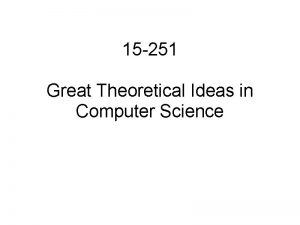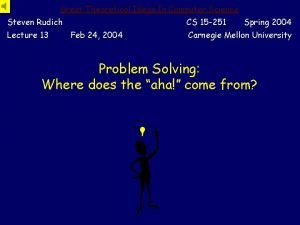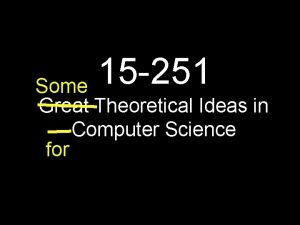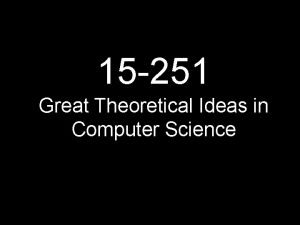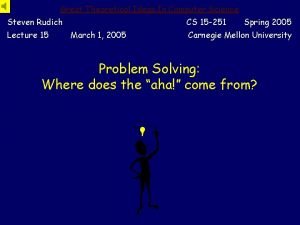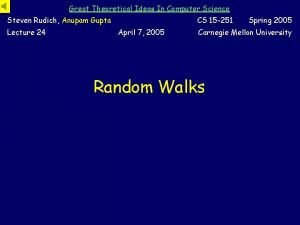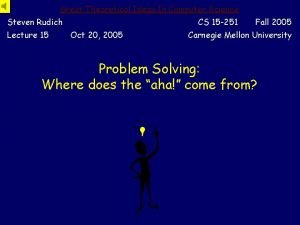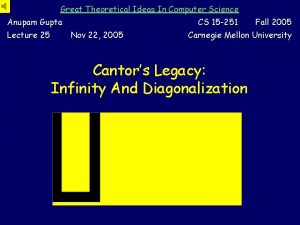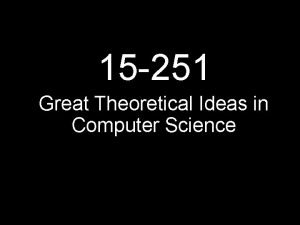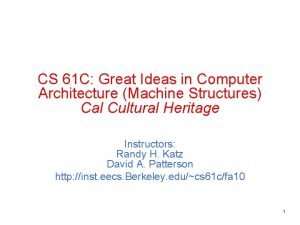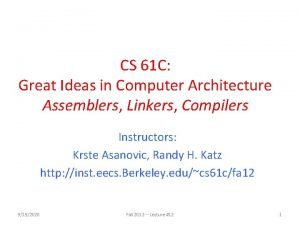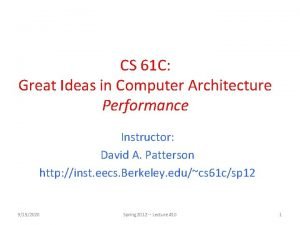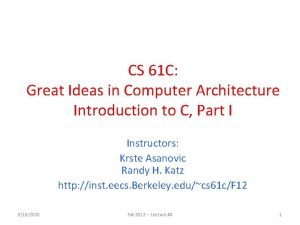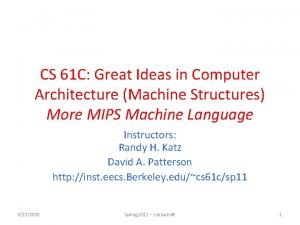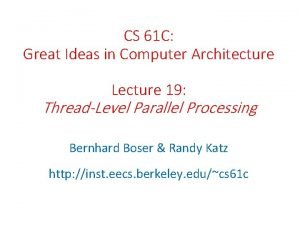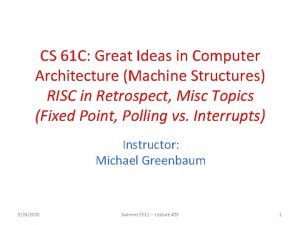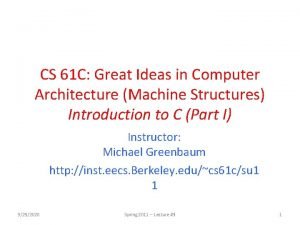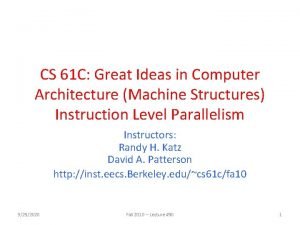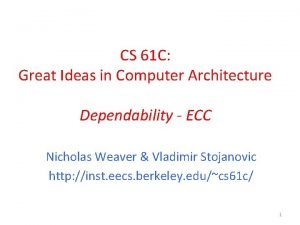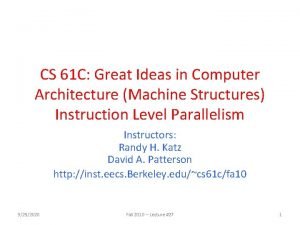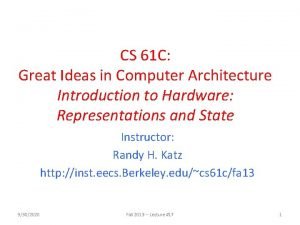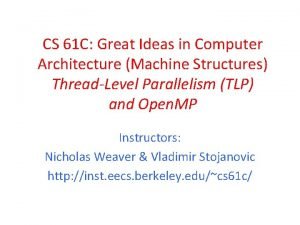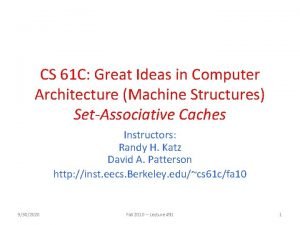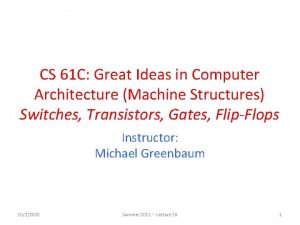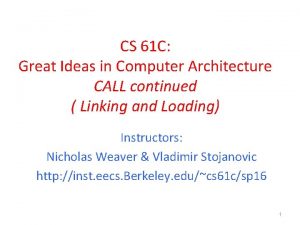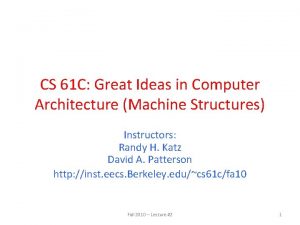CS 61 C Great Ideas in Computer Architecture















![+4 imm reg[1]+ reg[2] ALU Data memory 1 2 registers 3 add r 3, +4 imm reg[1]+ reg[2] ALU Data memory 1 2 registers 3 add r 3,](https://slidetodoc.com/presentation_image/149a646c6836b708627672b54c053ef4/image-16.jpg)

![imm 17 reg[1] <17? ALU Data memory 3 registers +4 x 1 slti r imm 17 reg[1] <17? ALU Data memory 3 registers +4 x 1 slti r](https://slidetodoc.com/presentation_image/149a646c6836b708627672b54c053ef4/image-18.jpg)
![Datapath Walkthroughs (3/3) • sw $r 3, 17($r 1) # Mem[r 1+17]=r 3 – Datapath Walkthroughs (3/3) • sw $r 3, 17($r 1) # Mem[r 1+17]=r 3 –](https://slidetodoc.com/presentation_image/149a646c6836b708627672b54c053ef4/image-19.jpg)
![x 1 imm 17 reg[3] ALU Data memory reg[1] MEM[r 1+17]<=r 3 3 registers x 1 imm 17 reg[3] ALU Data memory reg[1] MEM[r 1+17]<=r 3 3 registers](https://slidetodoc.com/presentation_image/149a646c6836b708627672b54c053ef4/image-20.jpg)

![Why Five Stages? (2/2) • lw $r 3, 17($r 1) # r 3=Mem[r 1+17] Why Five Stages? (2/2) • lw $r 3, 17($r 1) # r 3=Mem[r 1+17]](https://slidetodoc.com/presentation_image/149a646c6836b708627672b54c053ef4/image-22.jpg)










- Slides: 32

CS 61 C: Great Ideas in Computer Architecture (Machine Structures) Lecture 27: Single-Cycle CPU Datapath Design Instructor: Sr Lecturer SOE Dan Garcia http: //inst. eecs. Berkeley. edu/~cs 61 c/sp 13/

www. technologyreview. com/news/512891/software-makes-multiple-screens-less-distracting/ Technology In the News Software makes multiple screens less distracting Diff Displays from the University of St Andrews “uses eye-tracking software to sense when the user is not longer paying attention to a particular screen. It then replaces the content on that with the subtle visualization that reduces clutter and only highlights the new information”. Cool!

Review • Use muxes to select among inputs – S control bits selects from 2 S inputs – Each input can be n-bits wide, indep of S • Can implement muxes hierarchically • ALU can be implemented using a mux – Coupled with basic block elements • N-bit adder-subtractor done using N 1 bit adders with XOR gates on input – XOR serves as conditional inverter

Agenda • Stages of the Datapath • Datapath Instruction Walkthroughs • Datapath Design

Five Components of a Computer Processor Control Datapath Memory (passive) (where programs, data live when running) Devices Input Output Keyboard, Mouse Disk (where programs, data live when not running) Display, Printer

The CPU • Processor (CPU): the active part of the computer that does all the work (data manipulation and decision-making) • Datapath: portion of the processor that contains hardware necessary to perform operations required by the processor (the brawn) • Control: portion of the processor (also in hardware) that tells the datapath what needs to be done (the brain)

Stages of the Datapath : Overview • Problem: a single, atomic block that “executes an instruction” (performs all necessary operations beginning with fetching the instruction) would be too bulky and inefficient • Solution: break up the process of “executing an instruction” into stages, and then connect the stages to create the whole datapath – smaller stages are easier to design – easy to optimize (change) one stage without touching the others

Five Stages of the Datapath • • • Stage 1: Instruction Fetch Stage 2: Instruction Decode Stage 3: ALU (Arithmetic-Logic Unit) Stage 4: Memory Access Stage 5: Register Write

Stages of the Datapath (1/5) • There is a wide variety of MIPS instructions: so what general steps do they have in common? • Stage 1: Instruction Fetch – no matter what the instruction, the 32 -bit instruction word must first be fetched from memory (the cache-memory hierarchy) – also, this is where we Increment PC (that is, PC = PC + 4, to point to the next instruction: byte addressing so + 4)

Stages of the Datapath (2/5) • Stage 2: Instruction Decode – upon fetching the instruction, we next gather data from the fields (decode all necessary instruction data) – first, read the opcode to determine instruction type and field lengths – second, read in data from all necessary registers • for add, read two registers • for addi, read one register • for jal, no reads necessary

Stages of the Datapath (3/5) • Stage 3: ALU (Arithmetic-Logic Unit) – the real work of most instructions is done here: arithmetic (+, -, *, /), shifting, logic (&, |), comparisons (slt) – what about loads and stores? • lw $t 0, 40($t 1) • the address we are accessing in memory = the value in $t 1 PLUS the value 40 • so we do this addition in this stage

Stages of the Datapath (4/5) • Stage 4: Memory Access – actually only the load and store instructions do anything during this stage; the others remain idle during this stage or skip it all together – since these instructions have a unique step, we need this extra stage to account for them – as a result of the cache system, this stage is expected to be fast

Stages of the Datapath (5/5) • Stage 5: Register Write – most instructions write the result of some computation into a register – examples: arithmetic, logical, shifts, loads, slt – what about stores, branches, jumps? • don’t write anything into a register at the end • these remain idle during this fifth stage or skip it all together

+4 1. Instruction Fetch rd rs rt ALU Data memory registers PC instruction memory Generic Steps of Datapath imm 2. Decode/ Register Read 3. Execute 4. Memory 5. Register Write

Datapath Walkthroughs (1/3) • add $r 3, $r 1, $r 2 # r 3 = r 1+r 2 – Stage 1: fetch this instruction, increment PC – Stage 2: decode to determine it is an add, then read registers $r 1 and $r 2 – Stage 3: add the two values retrieved in Stage 2 – Stage 4: idle (nothing to write to memory) – Stage 5: write result of Stage 3 into register $r 3
![4 imm reg1 reg2 ALU Data memory 1 2 registers 3 add r 3 +4 imm reg[1]+ reg[2] ALU Data memory 1 2 registers 3 add r 3,](https://slidetodoc.com/presentation_image/149a646c6836b708627672b54c053ef4/image-16.jpg)
+4 imm reg[1]+ reg[2] ALU Data memory 1 2 registers 3 add r 3, r 1, r 2 PC instruction memory Example: add Instruction

Datapath Walkthroughs (2/3) • slti $r 3, $r 1, 17 # if (r 1 <17 )r 3 = 1 else r 3 = 0 – Stage 1: fetch this instruction, increment PC – Stage 2: decode to determine it is an slti, then read register $r 1 – Stage 3: compare value retrieved in Stage 2 with the integer 17 – Stage 4: idle – Stage 5: write the result of Stage 3 (1 if reg source was less than signed immediate, 0 otherwise) into register $r 3
![imm 17 reg1 17 ALU Data memory 3 registers 4 x 1 slti r imm 17 reg[1] <17? ALU Data memory 3 registers +4 x 1 slti r](https://slidetodoc.com/presentation_image/149a646c6836b708627672b54c053ef4/image-18.jpg)
imm 17 reg[1] <17? ALU Data memory 3 registers +4 x 1 slti r 3, r 1, 17 PC instruction memory Example: slti Instruction
![Datapath Walkthroughs 33 sw r 3 17r 1 Memr 117r 3 Datapath Walkthroughs (3/3) • sw $r 3, 17($r 1) # Mem[r 1+17]=r 3 –](https://slidetodoc.com/presentation_image/149a646c6836b708627672b54c053ef4/image-19.jpg)
Datapath Walkthroughs (3/3) • sw $r 3, 17($r 1) # Mem[r 1+17]=r 3 – Stage 1: fetch this instruction, increment PC – Stage 2: decode to determine it is a sw, then read registers $r 1 and $r 3 – Stage 3: add 17 to value in register $r 1 (retrieved in Stage 2) to compute address – Stage 4: write value in register $r 3 (retrieved in Stage 2) into memory address computed in Stage 3 – Stage 5: idle (nothing to write into a register)
![x 1 imm 17 reg3 ALU Data memory reg1 MEMr 117r 3 3 registers x 1 imm 17 reg[3] ALU Data memory reg[1] MEM[r 1+17]<=r 3 3 registers](https://slidetodoc.com/presentation_image/149a646c6836b708627672b54c053ef4/image-20.jpg)
x 1 imm 17 reg[3] ALU Data memory reg[1] MEM[r 1+17]<=r 3 3 registers +4 SW r 3, 17(r 1) instruction memory PC Example: sw Instruction reg[1] +17

Why Five Stages? (1/2) • Could we have a different number of stages? – Yes, and other architectures do • So why does MIPS have five if instructions tend to idle for at least one stage? – Five stages are the union of all the operations needed by all the instructions. – One instruction uses all five stages: the load
![Why Five Stages 22 lw r 3 17r 1 r 3Memr 117 Why Five Stages? (2/2) • lw $r 3, 17($r 1) # r 3=Mem[r 1+17]](https://slidetodoc.com/presentation_image/149a646c6836b708627672b54c053ef4/image-22.jpg)
Why Five Stages? (2/2) • lw $r 3, 17($r 1) # r 3=Mem[r 1+17] – Stage 1: fetch this instruction, increment PC – Stage 2: decode to determine it is a lw, then read register $r 1 – Stage 3: add 17 to value in register $r 1 (retrieved in Stage 2) – Stage 4: read value from memory address computed in Stage 3 – Stage 5: write value read in Stage 4 into register $r 3

3 registers +4 LW r 3, 17(r 1) instruction memory PC x 1 imm 17 ALU MEM[r 1+17] reg[1] Data memory Example: lw Instruction reg[1] +17

Peer Instruction How many places in this diagram will need a multiplexor to select one from multiple inputs? a) 0 b) 1 c) 2 d) 3 e) 4 or more

Peer Instruction How many places in this diagram will need a multiplexor to select one from multiple inputs a) 0 b) 1 c) 2 d) 3 e) 4 or more

Datapath and Control +4 imm opcode, funct Controller ALU Data memory rd rs rt registers PC instruction memory • Datapath based on data transfers required to perform instructions • Controller causes the right transfers to happen

What Hardware Is Needed? (1/2) • PC: a register that keeps track of address of the next instruction to be fetched • General Purpose Registers – Used in Stages 2 (Read) and 5 (Write) – MIPS has 32 of these • Memory – Used in Stages 1 (Fetch) and 4 (R/W) – Caches makes these stages as fast as the others (on average, otherwise multicycle stall)

What Hardware Is Needed? (2/2) • ALU – Used in Stage 3 – Performs all necessary functions: arithmetic, logicals, etc. • Miscellaneous Registers – One stage per clock cycle: Registers inserted between stages to hold intermediate data and control signals as they travel from stage to stage – Note: Register is a general purpose term meaning something that stores bits. Realize that not all registers are in the “register file”

CPU Clocking (1/2) • For each instruction, how do we control the flow of information though the datapath? • Single Cycle CPU: All stages of an instruction completed within one long clock cycle – Clock cycle sufficiently long to allow each instruction to complete all stages without interruption within one cycle 1. Instruction Fetch 2. Decode/ Register Read 3. Execute 4. Memory 5. Reg. Write

CPU Clocking (2/2) • Alternative multiple-cycle CPU: only one stage of instruction per clock cycle – Clock is made as long as the slowest stage 1. Instruction 2. Decode/ Fetch Register Read 3. Execute 4. Memory 5. Register Write – Several significant advantages over single cycle execution: Unused stages in a particular instruction can be skipped OR instructions can be pipelined (overlapped)

Processor Design • Analyze instruction set architecture (ISA) to determine datapath requirements – Meaning of each instruction is given by register transfers – Datapath must include storage element for ISA registers – Datapath must support each register transfer • Select set of datapath components and establish clocking methodology • Assemble datapath components to meet requirements • Analyze each instruction to determine sequence of control point settings to implement the register transfer • Assemble the control logic to perform this sequencing

Summary • CPU design involves Datapath, Control – 5 Stages for MIPS Instructions 1. 2. 3. 4. 5. Instruction Fetch Instruction Decode & Register Read ALU (Execute) Memory Register Write • Datapath timing: single long clock cycle or one short clock cycle per stage
 8 ideas of computer architecture
8 ideas of computer architecture Cs 61
Cs 61 8 great ideas in computer architecture
8 great ideas in computer architecture 8 great ideas in computer architecture
8 great ideas in computer architecture Great theoretical ideas in computer science
Great theoretical ideas in computer science Great theoretical ideas in computer science
Great theoretical ideas in computer science Great theoretical ideas in computer science
Great theoretical ideas in computer science Cse 111
Cse 111 Cmu 15251
Cmu 15251 Great theoretical ideas in computer science
Great theoretical ideas in computer science Great theoretical ideas in computer science
Great theoretical ideas in computer science Steven rudich
Steven rudich Great theoretical ideas in computer science
Great theoretical ideas in computer science Great theoretical ideas in computer science
Great theoretical ideas in computer science Great theoretical ideas in computer science
Great theoretical ideas in computer science Bus architecture in computer organization
Bus architecture in computer organization Difference between computer organization and architecture
Difference between computer organization and architecture Fgi and fgo in computer architecture
Fgi and fgo in computer architecture Ideas have consequences bad ideas have victims
Ideas have consequences bad ideas have victims Los deseos ridículos preguntas y respuestas
Los deseos ridículos preguntas y respuestas Unit 4 great ideas
Unit 4 great ideas Turning great strategy into great performance
Turning great strategy into great performance Faces of south dakota
Faces of south dakota Leadership comes with great responsibility
Leadership comes with great responsibility Hammerhead shark vs great white shark
Hammerhead shark vs great white shark Does alexander the great deserve his title
Does alexander the great deserve his title Frederick the great catherine the great enlightened despot
Frederick the great catherine the great enlightened despot With great expectations comes great responsibility
With great expectations comes great responsibility A great deal vs a great many
A great deal vs a great many With great power comes great responsibility
With great power comes great responsibility Does alexander deserve to be called the great
Does alexander deserve to be called the great Great is thy faithfulness oh god my father
Great is thy faithfulness oh god my father Software architecture business cycle
Software architecture business cycle

